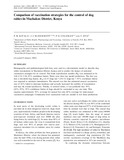| dc.contributor.author | Kitala, PM | |
| dc.contributor.author | McDermott, JJ | |
| dc.contributor.author | Coleman, PG | |
| dc.contributor.author | Dye, C | |
| dc.date.accessioned | 2013-06-27T15:18:27Z | |
| dc.date.available | 2013-06-27T15:18:27Z | |
| dc.date.issued | 2002-08 | |
| dc.identifier.citation | Epidemiol Infect. 2002 Aug;129(1):215-22. | en |
| dc.identifier.uri | http://hinari-gw.who.int/whalecomwww.ncbi.nlm.nih.gov/whalecom0/pubmed/12211590 | |
| dc.identifier.uri | http://erepository.uonbi.ac.ke:8080/xmlui/handle/123456789/41287 | |
| dc.description.abstract | Demographic and epidemiological field data were used in a deterministic model to describe dog rabies transmission in Machakos District, Kenya and to predict the impact of potential vaccination strategies for its control. The basic reproduction number (R0) was estimated to be 2.44 (1.52-3.36, 95% confidence limits). There were three key model predictions. The first was that a threshold dog density (K(T)) of 4.5 dogs km(-2) (3.8-5.2 dogs km(-2), 95% confidence limits) was required to maintain transmission. The second was that the estimated annual vaccination rate of 24% failed to decrease incidence and actually increased the stability of transmission and may be counter-productive. Thirdly, to control rabies, it was predicted that 59% (34%-70%, 95% confidence limits) of dogs should be vaccinated at any one time. This requires approximately 70% coverage for annual but only 60% coverage for semi-annual vaccination campaigns. Community-level vaccination trials are needed to test these predictions. | en |
| dc.language.iso | en | en |
| dc.publisher | University Of Nairobi. | en |
| dc.title | Comparison of vaccination strategies for the control of dog rabies in Machakos District, Kenya. | en |
| dc.type | Article | en |
| local.publisher | Department of Public Health, Pharmacology and Toxicology, University of Nairobi, Kenya | en |

